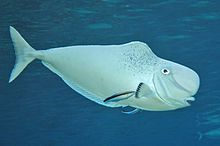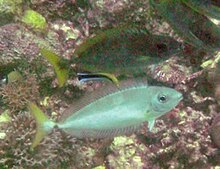Naso (fish)
| Naso | |
|---|---|

| |
| Bluespine unicornfish (N. unicornis) | |
| Scientific classification | |
| Domain: | Eukaryota |
| Kingdom: | Animalia |
| Phylum: | Chordata |
| Class: | Actinopterygii |
| Order: | Acanthuriformes |
| Family: | Acanthuridae |
| Subfamily: | Nasinae Fowler & Bean, 1929 |
| Genus: | Naso Lacépède, 1801 |
| Type species | |
| Acanthurus fronticornis Lacepède, 1801
| |
| Species | |
|
20., see text | |
| Synonyms[2] | |
|
List
| |
Naso is a genus of marine ray-finned fishes belonging to the family, Acanthuridae, the unicornfishes, surgeonfishes and tangs. The fishes in this genus are known commonly as unicornfishes because of the "rostral protuberance", a hornlike extension of the forehead present in some species.[3]
Unicorn fish are popular with spearfishermen[4] and may be cooked by grilling them whole.[5] Unicornfish primarily live around coral reefs and eat mostly algae.[6]
This genus is distributed across the Indo-Pacific from Africa to Hawaii.[7]
Taxonomy
[edit]Naso was first proposed as a genus in 1801 by Bernard Germain de Lacépède when he described Naso fronticornis as a new species from Jeddah and Mauritius.[2] Lacépède's name was an unnecessary replacement of Chaetodon unicornis described by Peter Forsskål in 1775 from Jeddah.[8] In 1917 David Starr Jordan designated Naso fronticornis as the type species of the genus Naso.[2] Naso is the only genus in the monogeneric subfamily Nasinae, proposed by Henry Weed Fowler and Barton Appler Bean in 1929[9] within the family Acanthuridae.[10]
Etymology
[edit]Naso means "nose" referring to the fleshy protuberance on the forehead of N. fronticornis (=unicornis). The subgenus Axinurus comes from axino and oura, meaning axe-tail, potentially referring to the presence of a single tail spine on each side as opposed to two in the subgenus Naso.[11]
Distribution
[edit]Naso unicornfishes are found in the Indo-Pacific region from the eastern coast of Africa to the Galápagos Islands.[12]
Characteristics
[edit]Naso unicornfishes have a pointed snout and a rhomboidal or oval shaped body, with some species possessing a long protuberance on the forehead, typically present in both males and females. The caudal peduncle is slender and there are 1 or 2 anteriorly directed sharp, blade-shaped spines mounted on bony plates on each side. The caudal fin varies from slightly rounded to highly emarginate. In some species there are long filaments at the tips of the lobes of the caudal fin, sometimes restricted to males. The dorsal fins of these fishes are supported by between 4 and 7 spines and between 24 and 31 soft rays while the anal fin contains 2 spines and 23 to 30 soft rays. There is a single spine and 3 soft rays in the pelvic fins and between 16 and 19 soft rays in the pectoral fins.[12]
The species in the genus Naso vary in size from a maximum published standard length of 30 cm (12 in) in the slender unicorn (N. minor) to a maximum published total length of 100 cm (39 in) in the whitemargin unicornfish (N. annulatus).[13]
There are two subgenera which are distinguished by the number of keels on the caudal peduncle with the nominate subgenus, Naso having a pair on each side of the peduncle while the subgenus Axinurus has a single keel on each side.[14]
Biology
[edit]Naso unicornfishes differ from other acanthurids in that they eat zooplankton rather than grazing on algae or detritus and that they tend to live at greater ranges of depth.[12]
Cephalic horn function
[edit]Some species exhibit a large horn on the forehead. It is uncertain what the purpose of this horn is. One explanation postulates that is a result of sexual selection, ie serving a purpose in competition and communication, which may be within or between the sexes, or both. Alternatively, it has been hypothesized that they instead perform a hydrodynamic function, assisting the species that exhibit them with precision movements. This is because both fast swimming "scombriform" shaped species and small species typically lack the horn, while it is only the large relatively slow-swimming species which display the horn.[15]
Molecular phylogenetics show that horns independently evolved multiple times within the genus, and only ever evolved in benthic feeding species. Similarly, benthic-feeding also evolved multiple times independently. In addition, pelagic feeding and the fast-swimming "scombriform" body shape appear to be plesiomorphic traits. This is because the basalmost species in Naso are the pelagic feeding "scombriform" species in the subgenus Axinurus, and because every other acanthurid genus comprises predominantly benthic feeders.[16]
In some species, both males and females display such a horn. In at least some species where this is the case, such as the bluespine unicornfish, the horn is slightly sexually dimorphic, being slightly larger in males.[15] In other species, such as the humpback unicornfish, the horn is almost completely absent in females.[12]
Species
[edit]Naso is divided into two subgenera[11] and 20 species are classified within it:[13]
| Species | Common name | Image |
|---|---|---|
| Naso annulatus | whitemargin unicornfish | 
|
| Naso brachycentron
(Valenciennes, 1835) |
humpback unicornfish | 
|
| Naso brevirostris
(G. Cuvier, 1829) |
spotted unicornfish | 
|
| Naso caesius
J. E. Randall & Bell, 1992 |
gray unicornfish | 
|
| Naso elegans
(Rüppell, 1829) |
elegant unicornfish | 
|
| Naso fageni
Morrow, 1954 |
horseface unicornfish | |
| Naso hexacanthus
(Bleeker, 1855) |
sleek unicornfish | 
|
| Naso lituratus
(J. R. Forster, 1801) |
orangespine unicornfish | 
|
| Naso lopezi
Herre, 1927 |
elongated unicornfish | |
| Naso maculatus
J. E. Randall & Struhsaker, 1981 |
spotted unicornfish | |
| Naso mcdadei
J. W. Johnson, 2002 |
squarenose unicornfish | 
|
| Naso reticulatus
J. E. Randall, 2001 |
reticulated unicornfish | 
|
| Naso tergus
H. C. Ho, K. N. Shen & C. W. Chang, 2011 |
Taiwanese unicornfish | |
| Naso tonganus
(Valenciennes, 1835) |
bulbnose unicornfish | 
|
| Naso tuberosus
Lacépède, 1801 |
humpnose unicornfish | 
|
| Naso unicornis
(Forsskål, 1775) |
bluespine unicornfish | 
|
| Naso vlamingii
(Valenciennes, 1835) |
bignose unicornfish | 
|
| Species | Common name | Image |
|---|---|---|
| Naso caeruleacauda J. E. Randall, 1994 | blue unicornfish | 
|
| Naso minor (J. L. B. Smith, 1966) | slender unicornfish | 
|
| Naso thynnoides (G. Cuvier, 1829) | oneknife unicornfish | 
|
References
[edit]- ^ Sepkoski, Jack (2002). "A compendium of fossil marine animal genera". Bulletins of American Paleontology. 364: 560. Retrieved 2008-01-08.
- ^ a b c Eschmeyer, William N.; Fricke, Ron & van der Laan, Richard (eds.). "Genera in the family Acanthuridae". Catalog of Fishes. California Academy of Sciences. Retrieved 10 July 2023.
- ^ Dayton, C. (2001). "Genetic evolution among selected members of the genus Naso (Nasinae), "unicornfishes" from Guam". Marine Biology. 139 (4): 771–76. Bibcode:2001MarBi.139..771D. doi:10.1007/s002270100628.
- ^ "Fishing at the tip of the spear in Guam". Archived from the original on 2018-12-31. Retrieved 2018-09-06.
- ^ "Unicorn Fish the weird but delicious fish". The Arena Media Brands, LLC. 5 November 2022. Retrieved 10 July 2023.
- ^ "Acanthuridae (Surgeonfishes/Tangs)". Reef App encyclopaedia for marine animals. Kasper Hareskov Tygesen. Retrieved 10 July 2023.
- ^ Borden, W. C. (1998). "Phylogeny of the unicornfishes (Naso, Acanthuridae) based on soft anatomy". Copeia. 1998 (1): 104–113. doi:10.2307/1447705. JSTOR 1447705.
- ^ Eschmeyer, William N.; Fricke, Ron & van der Laan, Richard (eds.). "Species in the genus Naso". Catalog of Fishes. California Academy of Sciences. Retrieved 11 July 2023.
- ^ Richard van der Laan; William N. Eschmeyer & Ronald Fricke (2014). "Family-group names of recent fishes". Zootaxa. 3882 (2): 1–230. doi:10.11646/zootaxa.3882.1.1. PMID 25543675.
- ^ J. S. Nelson; T. C. Grande; M. V. H. Wilson (2016). Fishes of the World (5th ed.). Wiley. pp. 497–502. ISBN 978-1-118-34233-6. Archived from the original on 2019-04-08. Retrieved 2023-07-11.
- ^ a b Christopher Scharpf & Kenneth J. Lazara, eds. (12 January 2021). "Order Acanthuriformes (part 2): Families Ephippidae, Leiognathidae, Scatophagidae, Antigoniidae, Siganidae, Caproidae, Luvaridae, Zanclidae and Acanthuridae". The ETYFish Project Fish Name Etymology Database. Christopher Scharpf and Kenneth J. Lazara. Retrieved 10 July 2023.
- ^ a b c d John E. Randall (2022). "Family Acanthuridae". In Phillip C Heemstra; Elaine Heemstra; David A Ebert; Wouter Holleman; John E Randall (eds.). Coastal Fishes of the Western Indian Ocean (PDF). Vol. 5. South African Institute for Aquatic Biodiversity. pp. 219–244. ISBN 978-1-990951-32-9.
- ^ a b Froese, Rainer; Pauly, Daniel (eds.). "Species in genus Naso". FishBase. February 2023 version.
- ^ John E. Randall (1994). "Unicornfishes of the Subgenus Axinurus (Perciformes: Acanthuridae: Naso), with Description of a New Species". Copeia. 1994 (1): 116–124. doi:10.2307/1446677. JSTOR 1446677.
- ^ a b DeMartini, Edward E. (July 2016). "Sexual Dimorphisms in the Bluespine Unicornfish, Naso unicornis (Acanthuridae): External Metrics for Movement Ecology and Life History". Copeia. 104 (2): 498–505. doi:10.1643/CE-15-270. ISSN 0045-8511.
- ^ Klanten, Selma O.; Herwerden, Lynne van; Choat, J.Howard; Blair, David (July 2004). "Patterns of lineage diversification in the genus Naso (Acanthuridae)". Molecular Phylogenetics and Evolution. 32 (1): 221–235. doi:10.1016/j.ympev.2003.11.008.
